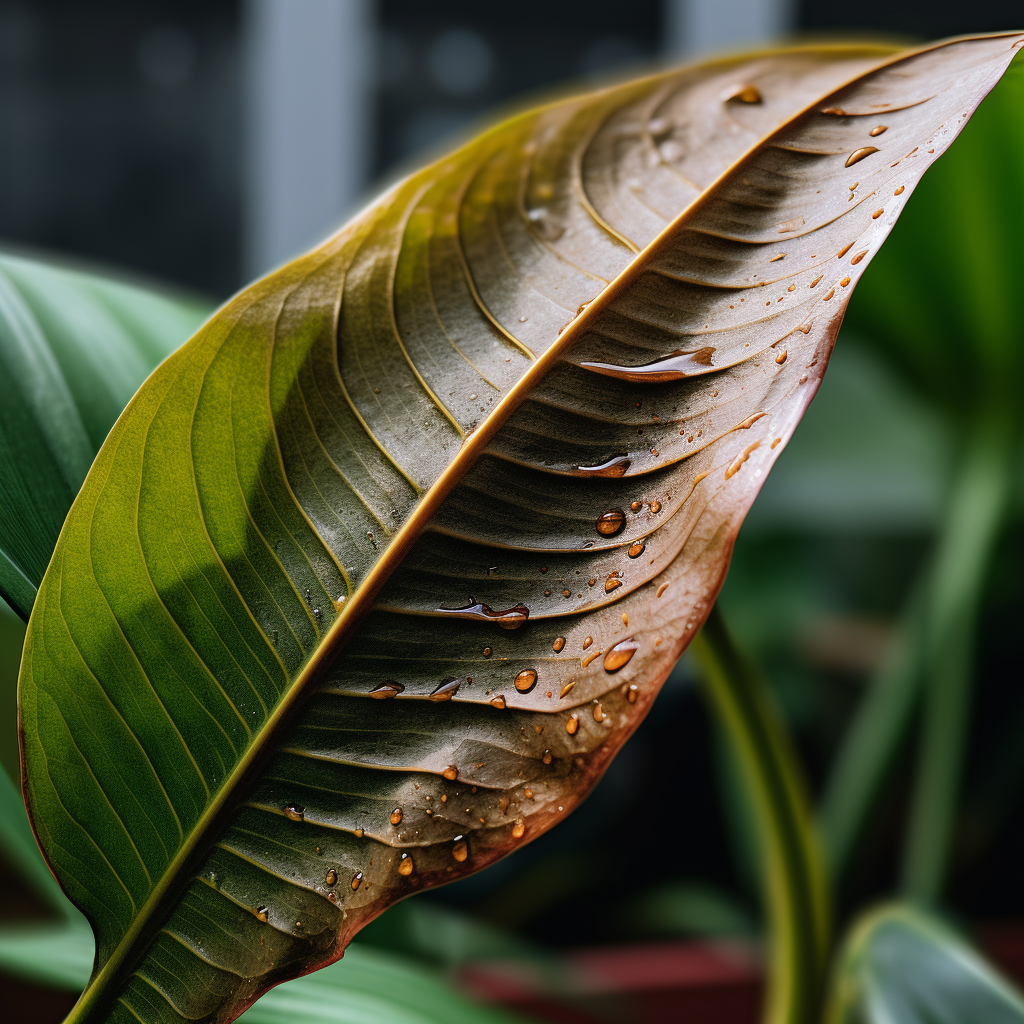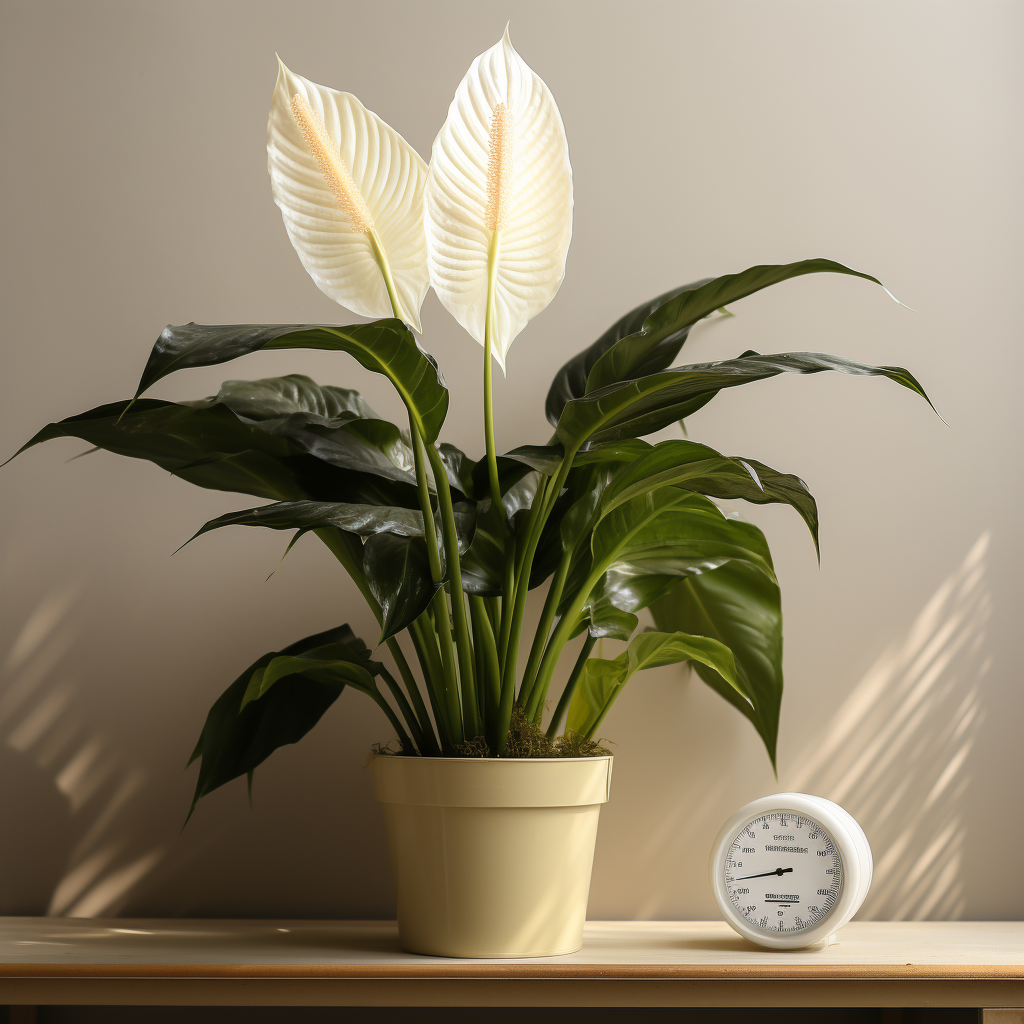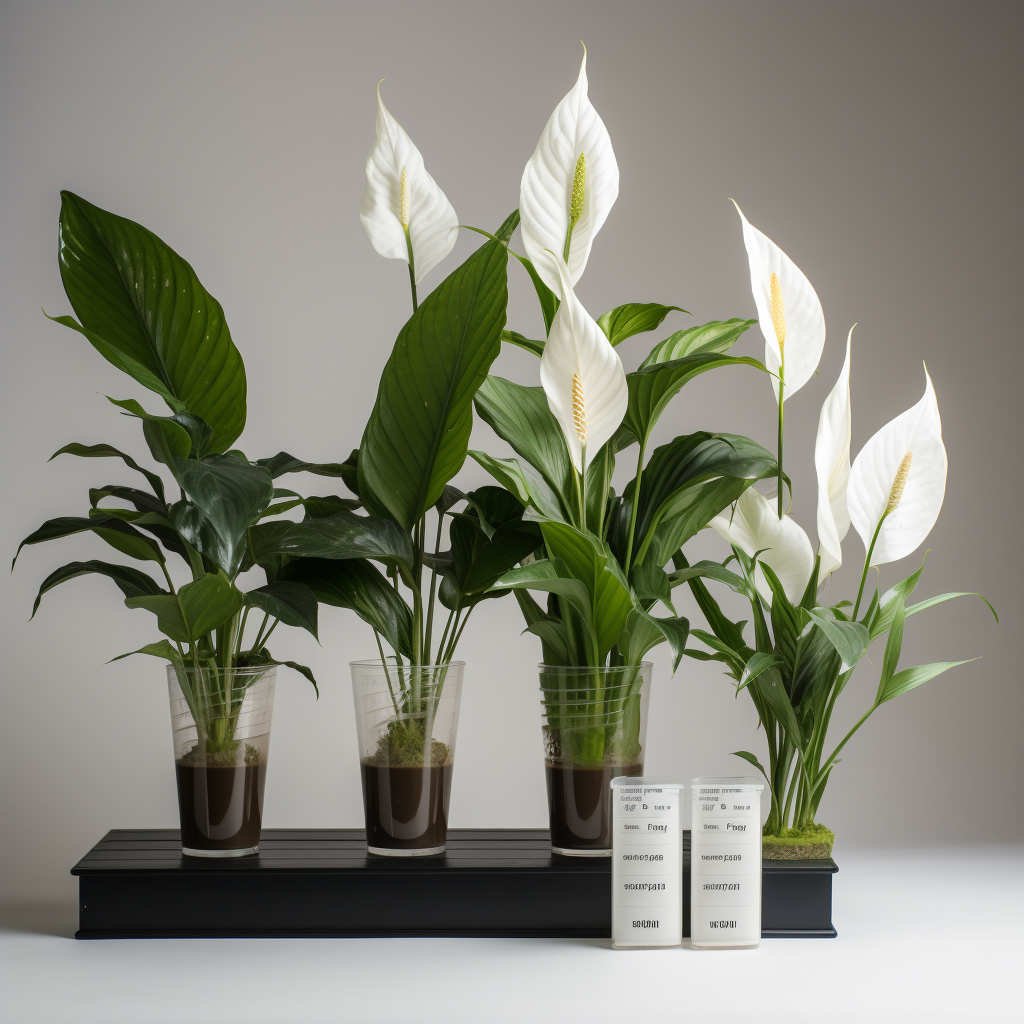
Introduction
Peace Lilies, often celebrated for their beauty and acclaimed as “easy” houseplants, carry an allure that captivates both seasoned gardeners and novices alike. Yet, in the pursuit of nurturing these elegant blooms, even the most experienced individuals can encounter an all-too-familiar frustration: the enigmatic browning of their delicate leaves. As a seasoned caretaker of indoor flora, I have weathered my fair share of battles with this perplexing issue, and I empathize with the exasperation that ensues.
The emergence of brown-tipped leaves in Peace Lilies can be a disheartening sight for any enthusiast, sparking feelings of bewilderment and an innate desire to restore these botanical wonders to their vibrant glory. In this comprehensive guide, we delve into the heart of the matter, exploring the primary causes behind the notorious brown tips that plague Peace Lilies. More than just a botanical woe, it’s a shared experience, a challenge that unites plant enthusiasts in their quest for healthier, thriving indoor gardens.
Through personal trials and shared anecdotes, this guide will unravel the mysteries behind Peace Lily browning, offering not just a superficial solution, but a deep dive into the intricate ecosystem within the potted soil. By understanding the fundamental triggers causing leaf discoloration, we aim not only to revive these exquisite plants but also to empower caregivers with knowledge, enabling them to foster lasting health and vitality in their beloved flora.
Join us on this expedition to decipher the secrets behind the browning of Peace Lilies, and together, let’s unlock the gateway to lush, thriving greenery within our homes.
Understanding the Issue: Peace Lily Browning
The manifestation of browning leaves in Peace Lilies serves as a distress signal, a visual cue that beckons caretakers to explore the underlying reasons behind this perplexing phenomenon. It’s a concern that resonates deeply within the hearts of plant aficionados, signaling a deviation from the lush vibrancy these plants are renowned for. This section aims to unravel the intricacies of Peace Lily browning, shedding light on its significance and the emotional frustrations it incites.
Visual Impact and Emotional Resonance
The emergence of brown tips on the leaves of Peace Lilies isn’t merely a cosmetic alteration. It stands as an indicator of an underlying issue within the plant’s environment or care regimen. This browning can start subtly, often on the tips of the otherwise verdant leaves, gradually expanding and encroaching upon the plant’s overall aesthetic. The emotional resonance it evokes is one of concern, frustration, and a strong desire to restore the plant to its former vitality. It’s a shared experience among plant enthusiasts, fostering a sense of camaraderie in the quest for healthier, more resilient indoor flora.
Importance of Prompt Resolution
While seemingly cosmetic, the presence of brown tips on Peace Lilies requires prompt attention. Addressing this issue proactively can prevent the exacerbation of underlying problems that might compromise the overall health of the plant. It’s not merely about restoring the visual appeal but ensuring the well-being of the Peace Lily, allowing it to thrive in its intended environment.
Triggers and Causes of Browning
The browning of Peace Lily leaves is a multifaceted issue with various underlying causes. It can be triggered by environmental factors, care routine missteps, or sometimes, a combination of both. By comprehensively understanding these triggers, we can effectively diagnose the root cause and implement precise solutions, reviving these delicate yet resilient plants.
This section sets the stage for a comprehensive exploration of the browning issue in Peace Lilies, emphasizing its significance, emotional impact, and the need for a proactive approach to resolve it. It establishes the groundwork for a detailed investigation into the root causes of this botanical dilemma, paving the way for informed solutions and a deeper understanding of fostering plant health.
Unveiling the Causes Behind Brown Tips

The perplexing emergence of brown-tipped leaves in Peace Lilies triggers a quest for understanding, leading caretakers into a labyrinth of potential triggers and underlying causes. Exploring these facets is crucial in the pursuit of reviving these elegant indoor plants. This section aims to unravel the primary causes behind the notorious browning of Peace Lily leaves, offering insight into the intricacies of their environment and care requirements.
- Moisture Stress: The Balancing Act
Peace Lilies are sensitive to moisture levels, and deviations from their ideal range can result in leaf browning. This can manifest in two extremes:
- Overwatering: Superfluous watering can suffocate the roots, leading to oxygen deprivation and subsequent browning. This might occur due to soil oversaturation or inappropriate pot size, hindering proper drainage.
- Underwatering: Insufficient water supply results in wilting leaves and dry, crisp tips, signaling a need for adequate hydration.
Addressing moisture stress necessitates a careful balance – understanding the right watering frequency, soil conditions, and pot size that facilitates optimal root health.
- Temperature Extremes: Striking the Right Balance
Temperature fluctuations, whether excessively hot or cold, can impact the Peace Lily’s health. Extreme heat can parch the plant, causing leaf discoloration, while cold temperatures might induce stress and browning.
Maintaining a temperate environment by avoiding extremes, and ensuring the plant’s placement away from direct heat sources or cold drafts, is crucial for a thriving Peace Lily.
- Lack of Humidity: Adapting to Environmental Conditions
Peace Lilies thrive in high humidity environments, often challenging in regions with low humidity levels. Supplementing humidity through strategies like misting leaves or using water-filled trays can aid in replicating a more favorable environment for the plant.
Adapting to these conditions ensures the plant’s overall well-being, even in less humid climates.
- Overfertilizing: A Caregiver’s Dilemma
Sometimes, an act of overzealous care manifests in browning tips – a consequence of excessive fertilization. Allowing a recovery period and refraining from additional fertilization for a set duration can aid the plant in recuperating.
Balancing the application of fertilizers is crucial to prevent stress-induced leaf browning.
- Sun Scorch: Finding the Sweet Spot
Excessive exposure to sunlight can lead to sunburn, resulting in brown tips on leaves. Adjusting the plant’s position to a spot with moderated sunlight prevents such occurrences.
Finding the right balance in sunlight exposure ensures the Peace Lily flourishes without succumbing to sun-related stress.
Unveiling these primary causes behind brown-tipped Peace Lily leaves sets the stage for a more detailed examination into each trigger, empowering caretakers with knowledge to navigate and resolve these issues effectively.
Detailed Solutions for Each Cause
Addressing the specific triggers behind brown-tipped leaves in Peace Lilies necessitates tailored solutions. Understanding the nuances of each cause is pivotal in resolving this botanical enigma. This section delves into comprehensive solutions for each identified cause, providing caretakers with actionable steps to revive and maintain the health of their cherished Peace Lilies.
- Moisture Stress: Finding the Balance
Overwatering: Rectify oversaturation by adjusting watering frequency and pot size. Repotting into a smaller container or enhancing soil drainage through soil amendments such as perlite can aid in restoring the plant’s root health.
Underwatering: Revive dehydrated plants by administering a thorough watering, followed by an appropriate liquid fertilizer to rejuvenate the wilted leaves.
- Temperature Extremes: Environmental Optimization
Maintain a conducive environment by regulating room temperature, keeping the plant away from direct sources of heat or cold drafts. Balancing temperature conditions ensures the Peace Lily’s vitality and minimizes stress-induced leaf browning.
- Lack of Humidity: Supplementing Moisture
For regions with low humidity, increase ambient moisture by misting the leaves or employing water-filled trays to elevate humidity levels. Mimicking a more humid environment aids the plant’s overall health, even in less ideal climatic conditions.
- Overfertilizing: Restoring Balance
Allow a recovery period by refraining from fertilization for a specific duration, at least four weeks or longer in cooler months. Reintroduce fertilization gradually, ensuring a balanced application to prevent stress-induced browning.
- Sun Scorch: Adjusting Exposure
Relocate the plant to a spot with moderated sunlight to prevent sunburn and subsequent browning. Ensuring an optimal balance in sunlight exposure fosters healthy growth without subjecting the plant to excessive sun-induced stress.
Providing detailed solutions for each identified cause offers a roadmap for caretakers to navigate and rectify specific issues that lead to brown-tipped leaves in Peace Lilies. Tailoring these solutions empowers caretakers with precise actions to revive and maintain the health of these delicate yet resilient indoor plants.
Proactive Care and Long-Term Maintenance
The quest to resolve brown-tipped leaves in Peace Lilies isn’t just about immediate solutions; it’s also about fostering ongoing health and preventing future occurrences. This section delves into proactive care strategies and long-term maintenance practices to ensure the sustained vitality of your cherished indoor plants.
Regular Monitoring and Vigilance
- Routine checks are instrumental in maintaining the well-being of Peace Lilies. Regularly inspect leaves for any signs of browning or stress. Adjust care practices promptly if any issues arise to prevent escalation.
Maintenance Tips for Preventive Care
- Consistent Watering Routine: Establish a balanced watering schedule, avoiding extremes of dryness or oversaturation. Monitor the soil moisture diligently, ensuring it’s appropriate for the plant’s needs.
- Optimal Environmental Conditions: Maintain moderate room temperatures, avoiding abrupt fluctuations. Ensure the plant’s placement in a suitable spot away from direct heat sources or cold drafts.
- Humidity Management: If living in a low-humidity area, consistently employ methods to increase moisture around the plant, such as misting or using water-filled trays.
- Careful Fertilization: Use fertilizers judiciously and at recommended intervals, preventing over-fertilization and its subsequent stress on the plant.
Balancing Care without Excessive Intervention
- While attentive care is crucial, it’s equally vital to strike a balance. Avoid excessive intervention that may inadvertently stress the plant. Allow the Peace Lily to adapt and grow naturally, intervening only when necessary to maintain its health.
- Maintaining a delicate equilibrium between attentive care and allowing the plant to thrive naturally ensures the long-term health of Peace Lilies.
- Fostering proactive care practices and instituting a regimen of long-term maintenance is pivotal in ensuring the sustained health and resilience of Peace Lilies. By implementing these strategies, caretakers can establish an environment conducive to the plant’s well-being, fostering lush, vibrant indoor greenery for the long haul.
Conclusion

The journey to decipher the mysteries behind brown-tipped leaves in Peace Lilies has been one of exploration, understanding, and empowerment. These elegant indoor plants, often celebrated for their grace and resilience, occasionally face challenges that manifest as subtle browning, signaling a cry for help. In our quest to address this issue, we’ve unveiled the primary causes and offered comprehensive solutions, empowering caretakers to navigate the complexities of plant care more effectively.
Through this guide, we’ve delved into the intricate triggers behind leaf browning, from moisture stress to temperature extremes, lack of humidity, overfertilizing, and sun scorch. By comprehensively understanding these causes, we’ve offered tailored solutions to rectify each issue, providing a roadmap for reviving the health of Peace Lilies.
However, our journey doesn’t end here. Embracing proactive care and long-term maintenance practices is key in fostering sustained health and preventing future occurrences. Regular monitoring, balanced watering, optimal environmental conditions, humidity management, and careful fertilization collectively contribute to a nurturing environment for these beautiful plants.
Remember, finding the delicate balance between attentive care and allowing the plant to thrive naturally is essential. Strive for an equilibrium that fosters the plant’s growth without excessive intervention, enabling it to adapt and flourish in its environment.
As caretakers, our pursuit of nurturing and understanding these botanical wonders is an ongoing journey. With the knowledge gleaned from this guide, we aim to empower every plant enthusiast to create an environment where their Peace Lilies thrive, radiating lush greenery and vibrant health.
May this guide serve as a compass in your journey toward fostering the vitality of your beloved Peace Lilies, enriching your indoor spaces with their exquisite beauty and resilient charm.
Additional Resources and Tools
Expanding your knowledge and accessing the right tools can significantly enhance your ability to care for and resolve issues concerning Peace Lilies with brown-tipped leaves. Here’s a curated list of resources and tools to aid in your journey:
- Online Communities and Forums:
Engage with fellow plant enthusiasts on online forums such as Reddit’s r/houseplants or various gardening forums. Share experiences, seek advice, and gather insights from a diverse community of plant lovers.
- Recommended Reading:
Explore reputable books on houseplant care and troubleshooting, such as “The House Plant Expert” by D.G. Hessayon or “The Complete Houseplant Survival Manual” by Barbara Pleasant. These resources offer comprehensive guidance on nurturing a variety of indoor plants.
- Plant Care Apps:
Consider using plant care apps like “Planta” or “SmartPlant” which offer features such as plant identification, care tips, watering reminders, and troubleshooting guides specific to Peace Lilies and other houseplants.
- Soil Moisture Meters:
Invest in a reliable soil moisture meter to accurately gauge the moisture content of your Peace Lily’s soil. Tools like these aid in determining the watering needs of your plant, preventing overwatering or underwatering issues.
- Humidity Gauges:
Utilize humidity gauges or hygrometers to measure the humidity levels around your plants, particularly beneficial if you reside in a low-humidity environment. Maintaining appropriate humidity is essential for the well-being of Peace Lilies.
- Plant-Safe Fertilizers:
Opt for plant-specific, balanced fertilizers suited for Peace Lilies. Consider organic or liquid fertilizers designed for indoor plants to provide necessary nutrients without risking over-fertilization.
- Gardening Centers and Nurseries:
Visit local gardening centers or nurseries where experts can offer personalized advice, recommend suitable potting mix, containers, or provide guidance on optimizing the plant’s environment.
- Online Plant Care Guides and Videos:
Explore reputable online resources, blogs, and YouTube channels dedicated to plant care. Websites like The Spruce, Houseplant Central, or Planterina often offer detailed care guides and troubleshooting tips for Peace Lilies and various houseplants.
These resources and tools serve as valuable assets in your journey to ensure the health and vibrancy of your Peace Lilies. Engaging with communities, accessing expert advice, and utilizing tools designed for plant care can significantly enrich your ability to nurture and troubleshoot issues that may arise.

Cat-Friendly Gardening: Creating a Safe Haven for Your Feline Friends
Table of Contents Introduction Hey there, fellow feline enthusiasts! 🐾 Welcome to a space where your garden becomes not just a patch of green but

From Lilies to Sago Palms: Protect Your Cat from These 10 Toxic Plants
Table of Contents Introduction: Keeping Your Furry Friend Safe from Toxic Plants Hey there, fellow cat lovers! We all know our feline companions can be

Cat Nutrition 101: Decoding Labels & Essential Nutrients A-Z!
Table of Contents Introduction As a cat owner, you want nothing but the best for your furry feline friend. And that includes providing them with
